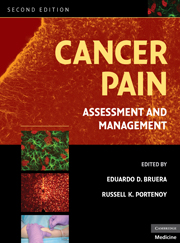Book contents
- Frontmatter
- Contents
- Contributors
- Preface
- SECTION I MECHANISMS AND EPIDEMIOLOGY
- SECTION II EPIDEMIOLOGY AND SYNDROMES
- SECTION III ASSESSMENT
- SECTION IV PHARMACOLOGICAL TREATMENT
- SECTION V OTHER INTERVENTIONAL STRATEGIES
- SECTION VI REHABILITATION AND PSYCHOLOGICAL INTERVENTIONS
- SECTION VII THE ROLE OF ANTINEOPLASTIC THERAPIES IN PAIN CONTROL
- SECTION VIII PAIN IN SPECIAL POPULATIONS
- SECTION IX DIFFICULT PAIN PROBLEMS
- SECTION X SYSTEMS OF CARE
- 29 Integrating cancer pain management into hospice practice and institution-based palliative care programs
- 30 Pain in medical illness: ethical and legal foundations
- 31 Understanding clinical trials in pain research
- 32 Legal and regulatory aspects of opioid treatment: the United States experience
- 33 Role of family caregivers in cancer pain management
- 34 Cancer pain and palliative care in the developing world
- Index
- Plate section
- References
34 - Cancer pain and palliative care in the developing world
from SECTION X - SYSTEMS OF CARE
Published online by Cambridge University Press: 06 July 2010
- Frontmatter
- Contents
- Contributors
- Preface
- SECTION I MECHANISMS AND EPIDEMIOLOGY
- SECTION II EPIDEMIOLOGY AND SYNDROMES
- SECTION III ASSESSMENT
- SECTION IV PHARMACOLOGICAL TREATMENT
- SECTION V OTHER INTERVENTIONAL STRATEGIES
- SECTION VI REHABILITATION AND PSYCHOLOGICAL INTERVENTIONS
- SECTION VII THE ROLE OF ANTINEOPLASTIC THERAPIES IN PAIN CONTROL
- SECTION VIII PAIN IN SPECIAL POPULATIONS
- SECTION IX DIFFICULT PAIN PROBLEMS
- SECTION X SYSTEMS OF CARE
- 29 Integrating cancer pain management into hospice practice and institution-based palliative care programs
- 30 Pain in medical illness: ethical and legal foundations
- 31 Understanding clinical trials in pain research
- 32 Legal and regulatory aspects of opioid treatment: the United States experience
- 33 Role of family caregivers in cancer pain management
- 34 Cancer pain and palliative care in the developing world
- Index
- Plate section
- References
Summary
Introduction
Throughout the world, millions of people suffer from chronic diseases, HIV/AIDS, and the aging process. The majority of these people are living in developing countries, where resources are limited, diseases often are diagnosed late, and curative facilities are scarce.
The World Health Organization (WHO) estimates that 58 million people per year will die during the projection period 2005–2010, and that most of these deaths (45 million) will occur in less-developed countries.
At least 35 million (60%) of those dying every year will have a prolonged, advanced illness, with similar needs – physical, psychological, social, and existential – that are relatively independent of the diseases from which they suffer. In fact, 60% of cancer patients will have pain.
Cancer pain management (CPM) and palliative care (PC) delivered according to WHO guidelines provide cost-effective care to relieve suffering and improve the quality of life of patients and families. Millions of people need access to them as part of an integral response to their needs. However, the provision of CPM and PC in developing countries is a problem; with very few exceptions, these programs are not yet incorporated into health systems, and tragically the vast majority of patients do not have access to them.
Because of the aforementioned reasons, some experts estimate that many patients, most from developing countries, are not getting the quality of care they should receive; effective CPM and PC are not available to all those who need them because of a lack of appropriate policies, inadequate education of health personnel, poor drug availability and accessibility, and lack of public awareness that suffering can be reduced with relatively inexpensive methods.
- Type
- Chapter
- Information
- Cancer PainAssessment and Management, pp. 608 - 626Publisher: Cambridge University PressPrint publication year: 2009



